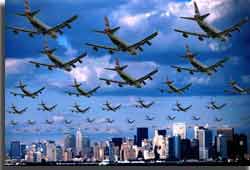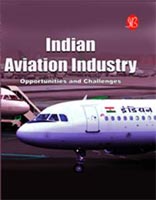| Size of the INDUSTRY | There are about 450 airports and 1091 registered aircrafts in India Today. |
| Geographical distribution | Mumbai, Kolkata, Hyderabad, Delhi, Pune, Bangalore, Chennai. |
| Output per annum | Growth rate of 18% per annum |

By the year 2000 several private airlines have entered into the aviation business in succession and many more were about to enter into the arena. Indian aviation industry today is dominated by private airlines and low-cost carriers like Deccan Airlines, GoAir, and SpiceJet, etc. And Indian Airlines, the giant of Indian air travel industry, gradually lost its market share to these private airlines. According to the report of CAPA, these budget carriers are likely to double their market share by 2010 -- one of the highest in the world.
In 2009 with increase in traffic movement and increase in revenues by almost US$ 21.4 million, the Airports Authority of India seems set to accrue better margins in 2009-10, as per the latest estimates released by the Ministry of Civil Aviation.

Today Hyderabad International Airport has been ranked amongst the world's top five in the annual Airport Service Quality (ASQ) passenger survey along with airports at Seoul, Singapore, Hong Kong and Beijing. This airport in Hyderabad is managed by a public-private joint venture consisting of the GMR Group, Malaysia Airports Holdings Berhad and both the State Government of Andhra Pradesh and the Airports Authority of India (AAI).
The Indian aviation sector can be broadly divided into the following main categories:
- Scheduled air transport service includes domestic and international airlines.
- Non-scheduled air transport service consists of charter operators and air taxi operators.
- Air cargo service, which includes air transportation of cargo and mail.
- Domestic airlines, which provide scheduled flights within India and to select international destinations. Air Deccan, Spice Jet, Kingfisher Airline and IndiGo are some of the domestic players in the industry.
- International airlines operate from scheduled international air services to and from India.
Non-scheduled air transport service: It is an air transport service other than the scheduled one and may be on charter basis and/or non-scheduled basis. The operator is not permitted to publish time schedule and issue tickets to passengers.
Air cargo services: It is an air transportation of cargo and mail. It may be on scheduled or non-scheduled basis. These operations are to destinations within India. For operation outside India, the operator has to take specific permission of Directorate General of Civil Aviation demonstrating his capacity for conducting such an operation.
Players in Indian aviation industry can be classified into three groups:
- Public players
- Private players
- Start up players
There are three public players: Air India, Indian Airlines and Alliance Air. The private players include Jet Airways, Air Sahara, Paramount airways, Go Air Airlines, Kingfisher Airlines, Spice Jet, Air Deccan and many more. The start up players is those which are planning to enter into the markets. Some of them are Omega Air, Magic Air, Premier Star Air and MDLR Airlines.

Aviation sector provides the following types of opportunities:
- Commercial pilot
- Co-pilot
- Air cargo pilot
- Expert cabin crew
- Air traffic controller
- Cabin safety instructor
- In-flight managers
- In-flight base managers
- Cabin services instructor
- Cabin crew
- Training instructor
- Maintenance controllers
- Licensed aircraft maintenance engineering
- Quality control manager.
- Cargo officers
- Guest service agent
- Ground staff
The government has formed National Aviation Company Ltd (NACIL) by merging national carriers Air India and Indian Airlines into a single entity. The blue print was prepared by the civil aviation ministry to convert Delhi airport into an international hub for passenger airlines and has been done so recently.
 Recent Press Release
Recent Press Release
 INDIAN ADVIATION INDUSTRY AT A Glance IN 2019 - 2020
INDIAN ADVIATION INDUSTRY AT A Glance IN 2019 - 2020
 INDIAN ADVIATION INDUSTRY AT A Glance IN 2018 - 2019
INDIAN ADVIATION INDUSTRY AT A Glance IN 2018 - 2019
 INDIAN ADVIATION INDUSTRY AT A Glance IN 2017 - 2018
INDIAN ADVIATION INDUSTRY AT A Glance IN 2017 - 2018
 INDIAN ADVIATION INDUSTRY AT A Glance IN 2016 - 2017
INDIAN ADVIATION INDUSTRY AT A Glance IN 2016 - 2017
 INDIAN ADVIATION INDUSTRY AT A Glance IN 2015 - 2016
INDIAN ADVIATION INDUSTRY AT A Glance IN 2015 - 2016
 INDIAN ADVIATION INDUSTRY AT A Glance IN 2014 - 2015
INDIAN ADVIATION INDUSTRY AT A Glance IN 2014 - 2015
 INDIAN ADVIATION INDUSTRY AT A Glance IN 2013 - 2014
INDIAN ADVIATION INDUSTRY AT A Glance IN 2013 - 2014
 INDIAN ADVIATION INDUSTRY AT A Glance IN 2012 - 2013
INDIAN ADVIATION INDUSTRY AT A Glance IN 2012 - 2013
 INDIAN ADVIATION INDUSTRY AT A Glance IN 2011 - 2012
INDIAN ADVIATION INDUSTRY AT A Glance IN 2011 - 2012
 The Federation of Indian Airlines (FIA)
The Federation of Indian Airlines (FIA)
 |
INDIAN INDUSTRIES |


